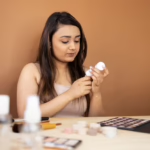Guide for Finding Foundation :- Finding foundation can be an intimidating task, especially if you don’t know which shade will work for your complexion. If this is something that is becoming an issue for you, look no further – our ultimate guide offers all of the tips and advice to confidently choose a foundation hue tailored specifically to you!
From learning how to recognize your skin tone to testing products in store, this guide will equip you with all the knowledge you need to find a foundation shade that matches up with your natural complexion. From lightweight liquid foundations to full coverage powder foundations, there will be something suitable just for you – so let’s get you on your journey toward finding your ideal foundation shade!
Guide Finding Foundation
1) Identifying Your Skin Tone
Finding the appropriate foundation shade begins by understanding your skin tone. Your skin tone refers to the colour of your skin, which varies from person to person depending on ethnicity and lifestyle choices. There are three primary skin tones. Fair skin tones refers to anyone whose complexion naturally leans fairer or paler than average; those with fair skin tones tend to burn easily in sunlight so heavier coverage foundations should generally be avoided in order to avoid looking cakey.
Medium Skin Tones: People who possess natural medium skin tones fall under the medium skin tone category, making up most people of Asian, Latino and Middle Eastern descent. People with medium skin tones generally exhibit healthy and even skintone. Dark Skin Tones: People who possess darker skin tones tend to possess darker or olive skintones; this allows them to have naturally darker tanned skin; dark tones typically require heavier coverage foundation for flawless coverage.
2) Testing Products In Store
When purchasing foundation, it’s essential that you test its color on your skin prior to purchasing. No two people have identical skin tones or undertones; therefore the colour that looks great on one person may not complement another’s complexion at all. Some advice says testing foundation on jawlines; however the best place for finding your ideal shade should be on cheekbones.
Your natural skin tone best represents your complexion, so once you find the foundation shade that best matches it, make a note of both product name and shade number so it will be easier for you to locate again in future.
3) Shopping Online

Online shopping is an efficient and simple way to locate a foundation shade to complement your skin tone, but finding the ideal product may take more time and patience than expected. When selecting foundations online, first consider their shade range before selecting an ideal candidate based on product description or reviews from previous buyers.
Once you’ve decided on a foundation, be sure to test it on your skin to make sure it suits. If possible, give the product some time in your routine so it can adjust itself to you; also identify its undertone to see if it matches up with your complexion.
4) Choosing The Right Finish
Once you know your skin tone, the next step in finding the ideal foundation finish is selecting one to meet your desired coverage and skin type needs. Foundation options range from lightweight dewy coverage to heavier full coverage foundations; your selection should depend on both. Sheer foundations: Sheer foundations offer lightweight dewy coverage that’s ideal for people with naturally dry skin types and those who like using water-based moisturisers.
If you have oily skin, heavier coverage foundation may be preferred. Light foundations offer moderate, buildable coverage which are great for those with normal skin while BB cream may provide lighter coverage suitable for oily skin types. Medium coverage foundations offer heavy coverage great for people with normal to oily skin types.
If your skin is extremely oily, medium coverage foundation may be best. Full foundations offer the highest coverage and should only be chosen if you desire flawless, heavy coverage – this type of foundation can often help disguise acne scarring or other blemishes. However, for extremely oily skin types a lighter coverage foundation might be preferred.
5) Finding The Right Shade
Once you find a foundation you think may suit your skin, be sure to verify the color before purchasing in store. This step is particularly important since colors cannot be tested beforehand. Typically, this information can be found on the bottle or tube’s back; otherwise look out for “contents.”
This will usually feature a list of ingredients used in a foundation as well as their respective colours, and you should attempt to identify its undertones to see if they suit your skin tone. If in doubt as to which shade to select, always opt for one shade darker than your natural complexion to prevent too much brightness for you skin tone.
Also Refer:- Best 5 Type Of Identify For Your Skin Type
Conclusion
Finding your ideal foundation shade may seem challenging, but it’s an integral part of beauty routines. Whether shopping online or in-store, it is crucial that you test the shade on your skin prior to making a purchase and ensure it matches perfectly with what’s already there. Once you find it though, rest assured it will look flawless every time! Just remember – that perfect foundation hue exists somewhere out there somewhere and that it won’t take you long to discover it.


